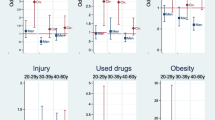Abstract
Conscription comples 70% of male Norwegians to invest 1 year of their lives in military training. For 19-to 20-year-old men, the military service is an important arena of secondary socialization. In a cross-sectional study of mental health in army conscripts using the 12-item General Health Questionnaire (GHQ), the case prevalence was 48% (cut-off 2/3). This was remarkably high, given that the study population had been screened for mental disease on several occasions, and a large number of recruits with symptoms of mental disease had been excluded before the survey began. Statistical analyses indicated that the high case prevalence was mainly due to situational factors. Four dimensions were identified: (1) social relations with officers, peers and family, (2) structural factors inherent in the system of obligatory military service, (3) the meaningfulness of daily tasks and (4) financial problems. GHQ caseness was statistically associated with physical inactivity and consumption of junk-food, tobacco, alcohol and cannabis. It is concluded that military service in its present form may have undesirable consequences both for civilian society and for military efficiency. Recruits need help to cope with the complex psychosocial and transactional challenges of military service.
Similar content being viewed by others
References
Arkin W, Dobrofsky LR (1978) Military socialization and masculinity. J Soc Issues 34: 151–168
Grøgaard JB, Ugland OF (1992) One for all. Who goes through the military service? A study of completion and attrition among Norwegian conscripts 1970–1990 (in Norwegian). FAFO, Oslo
Goldberg D, Williams P (1988) A user's guide to the General Health Questionnaire. NFER-Nelson, Windsor
Singh B, Lewin T, Beverley R, Johnston P, Walton J (1987) Minor psychiatric morbidity in a casualty population: identification, attempted intervention and six-month follow-up. Aust N Z J Psychiatry 21: 231–240
Wall TD, Clegg CW (1981) Individual strain and organizational functioning. Br J Clin Psychol 20: 135–136
Kim J-O, Mueller CW (1978) Factor analysis. Statistical methods and practical issues, Sage, London
SAS Institute (1987) SAS/STAT guide for personal computers, 6th edn. Cary, N.C.
Goodchild ME, Duncan-Jones P (1985) Chronicity and the General Health Questionnaire. Br J Psychiatry 146: 55–61
Winefield HR, Goldney RD, Winefield AH, Tiggemann M (1989) The General Health Questionnaire: reliability and validity for Australian youth. Aust N Z J Psychiatry 23: 53–58
Cox B, Blaxter M, Buckle A, et al (1987) The health and lifestyle survey. Health Promotion Research Trust Cambridge
O'Brien LS (1985) Psychiatric morbidity in a military general practice. J R Army Med Corps 131: 16–18
Henderson S, Duncan-Jones P, Byrne DG, Scott R, Adcock S (1979) Psychiatric disorder in Canberra. A standardised study of prevalence. Acta Psychiatr Scand 60: 355–374
Goffman E (1961) Asylums. Essays on the social situation of mental patients and other imates. Penguin, Harmondsworth
Frankl V (1978) The unheard cry for meaning. Psychotherapy and humanism. Washington Square Press, New York
Antonovsky A (1987) Unraveling the mystery of health. How people manage stress and stay well. Jossey-Bass, London
Atkinson RM (1971) Ineffective personnel in military service: a critique of concepts and rehabilitation practices from a psychiatric viewpoin. Amer J Psychiat 127: 1612–1618
Schei E, Søgaard A-J (1994) The impact of military service on young men's smoking habits. Preventive Medicine (In Press)
Schei E, Fønnebø V, Aarø LE (1990) Use of smokeless tobacco among conscripts. Prev Med 19: 667–674
Bovim G, Aaasland OG, Tyssedal JS (1990) Changes in use of alcohol and tobacco in military training school (in Norwegian). J Norw Med Assoc 110: 1705–1706
Novaco RW, Cook TM, Sarason IG (1983) Military recruit training. An arena for stress-coping skills. In: Meichenbaum D, Jaremko ME (eds) Stress reduction and prevention. Plenum Press, New York, pp 377–418
Author information
Authors and Affiliations
Rights and permissions
About this article
Cite this article
Schei, E. A strengthening experience? Mental distress during military service. Soc Psychiatry Psychiatr Epidemiol 29, 40–45 (1994). https://doi.org/10.1007/BF00796447
Accepted:
Issue Date:
DOI: https://doi.org/10.1007/BF00796447




